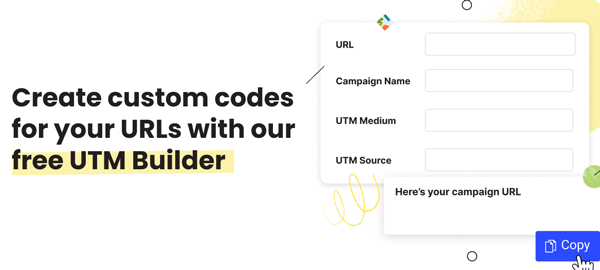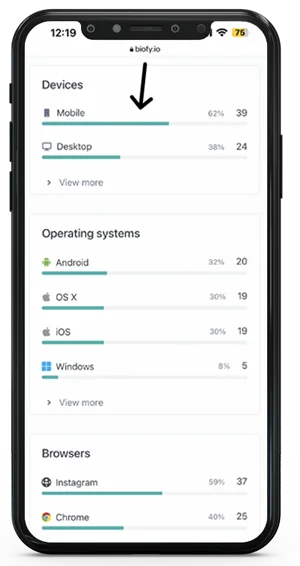


Here, you have the option to review the analytics, which shows the number of people who opened the link on mobile and desktop devices.


Additionally, you can review individual Biolink statistics at this location.


And you can also overview


Here, you can obtain your short URL, and you will find some features available.


Here, you have the option to view the analytics that reveals the countries from which the visits originated, the devices used for accessing the link, and whether the visits were direct or referred
Link analytics refers to the process of tracking and analyzing data related to links. It involves collecting information on link clicks, user behavior, and other metrics to gain insights into the performance and effectiveness of links shared online.a
Link analytics provides valuable data and insights for various purposes, including:
• Measuring the success of marketing campaigns.
• Understanding user engagement and behavior.
• Identifying the most effective referral sources.
• Optimizing website performance and conversion rates.
• Tracking the impact of social media shares and other promotional activities.
Link analytics typically involves appending tracking parameters to the URL, which allows the analytics system to gather data when the link is clicked. These parameters can include information about the source of the link, campaign details, or other custom data. When a user clicks the link, the analytics system records the relevant data and provides reports and insights based on that information.
A UTM builder is a tool or feature that helps create UTM parameters for URLs. UTM parameters are tags added to URLs to track and identify specific marketing campaigns, sources, mediums, and other relevant information about website traffic.
UTM parameters, also known as UTM tags or UTM codes, are short snippets of text added to the end of a URL. They help track and categorize website traffic from different sources. UTM parameters consist of key-value pairs, such as utm_source=facebook or utm_medium=email, which provide insights into the origin and context of a link click.
UTM parameters serve several purposes:
• They help identify the source of website traffic, such as a specific social media platform or email campaign.They help identify the source of website traffic, such as a specific social media
• They enable tracking and analysis of marketing campaign performance, allowing you to measure the effectiveness of different channels and campaigns.
• They provide insights into user behavior, helping you understand which channels or campaigns drive the most engagement and conversions.
• They facilitate data-driven decision-making, allowing you to optimize marketing efforts based on the data collected through UTM parameters.
platform or email campaign.
GDPR stands for General Data Protection Regulation. It is a comprehensive data protection regulation implemented by the European Union (EU) to safeguard the privacy rights of individuals. GDPR came into effect on May 25, 2018, and applies to organizations that process the personal data of individuals residing in the EU, regardless of where the organization is located.
GDPR aims to provide individuals with greater control over their personal data and establish a consistent framework for data protection within the EU. The key objectives of GDPR include:
• Strengthening the rights of individuals regarding their personal data.
• Promoting transparency and accountability in data processing practices.
• Harmonizing data protection laws across EU member states.
• Ensuring organizations implement appropriate security measures to protect personal data.
• Enabling individuals to exercise control over their data through consent mechanisms and rights, such as the right to access, rectify, and erase their personal information.
The key principles of GDPR include:
• Lawfulness, fairness, and transparency: Personal data must be processed lawfully, fairly, and transparently, with clear and specific purposes.
• Purpose limitation: Personal data should only be collected for specified and legitimate purposes and not processed in a manner incompatible with those purposes.
• Data minimization: Organizations should only collect and process personal data that is necessary for the intended purpose and limit the data to what is relevant.
• Accuracy: Personal data should be accurate and kept up to date, with measures in place to rectify or erase inaccurate data.
• Storage limitation: Personal data should be retained only for as long as necessary for the intended purpose and should be securely deleted when no longer required.
• Security and confidentiality: Organizations must implement appropriate technical and organizational measures to protect personal data from unauthorized access, loss, or disclosure.
• Accountability: Organizations are responsible for demonstrating compliance with GDPR principles, maintaining records of data processing activities, and being able to respond to data subject requests and regulatory inquiries.